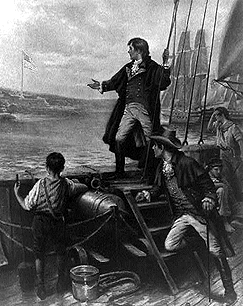 Key, Francis Scott 1779–1843, American poet.
Key, Francis Scott 1779–1843, American poet.The Star-spangled Banner American national anthem, beginning, “O say can you see by the dawn's early light.” The words were written by Francis Scott Key, a young Washington attorney who, during the War of 1812, sailed to the British fleet to obtain the release of a captured American. Key was detained by the British and witnessed from ship the bombardment of Fort McHenry during the night of Sept. 13–14, 1814. The fort withstood the attack, and the sight of the American flag flying at dawn inspired Key's verses, which were written on the way ashore in the morning. Although the army and the navy had for some years regarded “The Star-spangled Banner” as the national anthem, its designation as such first became official by executive order of President Wilson in 1916. This order was confirmed by act of Congress in 1931. The large flag that inspired the anthem, with 15 stars and stripes and originally 30-by-42-ft (9.1-by-12.8-m), has been in the collection of the Smithsonian Institution since 1912.
He was an army officer (1792–96), serving in a number of engagements with Native Americans. In 1803 he was chosen by his friend Meriwether Lewis to accompany the overland expedition to the Pacific. His observations of nature enlarged the findings of the expedition; his journals and maps recorded its history. In 1807, after the expedition had returned, Clark was appointed superintendent of Indian affairs, with headquarters at St. Louis, and from 1813 to 1838 he was governor of Missouri Territory. During the War of 1812, he led (1814) an expedition against the British and Native Americans in the upper Mississippi valley; upon reaching Prairie du Chien, Wis., he built Fort Shelby.


No comments:
Post a Comment